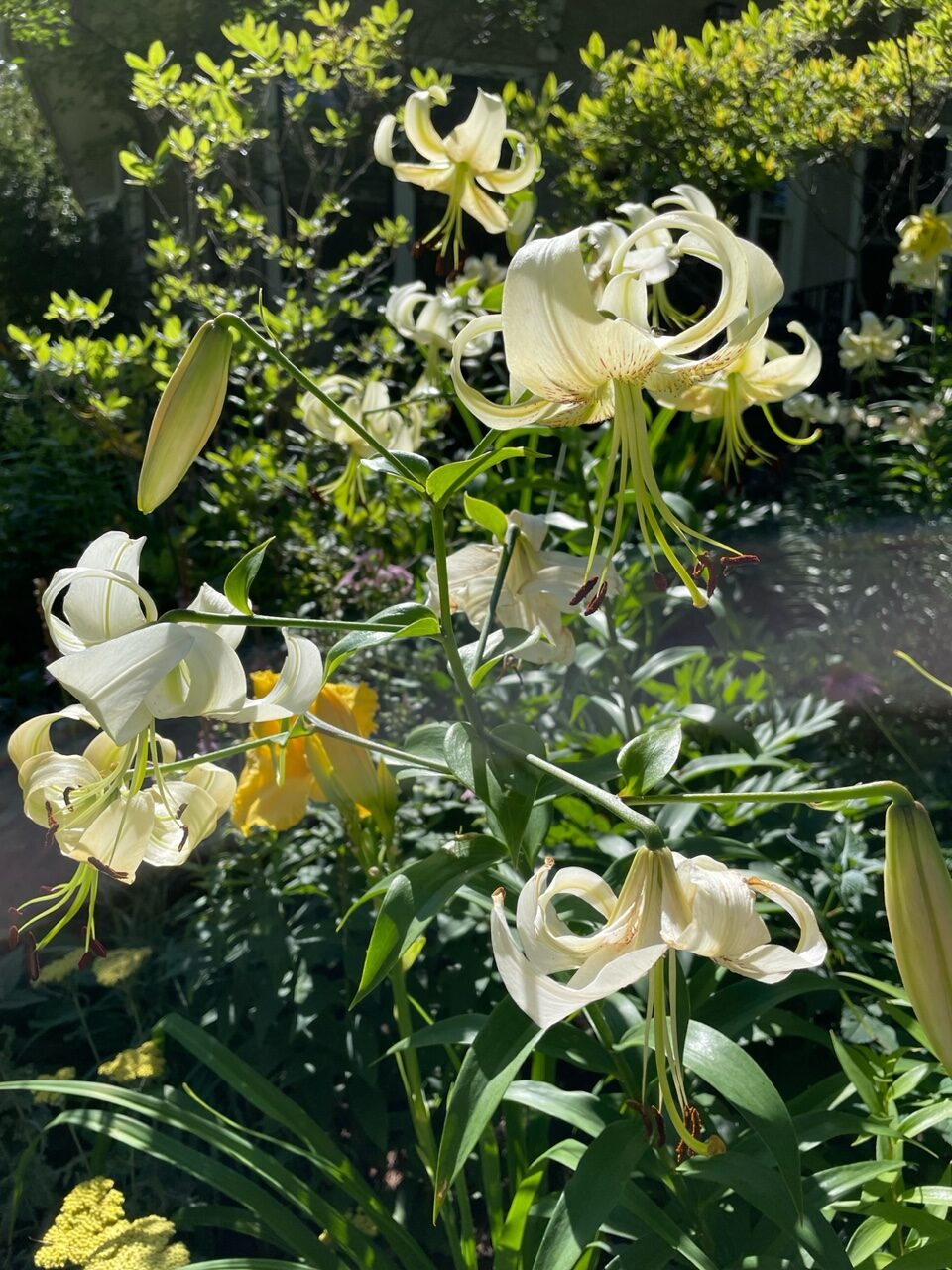
Today we’re in St. Paul, Minnesota, visiting with Susan Warde.
Tulips don’t do well for me, and I don’t have many daffodils, but here’s a seasonal tour of some bulb or bulblike plants that grow in my garden.
Dutchman’s breeches (Dicentra cucullaria, Zones 3–8) is a native spring ephemeral. Technically the underground parts consist of tubers, but they are decidedly bulblike. Interspersed with the ferny leaves of the Dutchman’s breeches are Siberian squill (Scilla siberica, Zones 2–8), which turns the entire garden into a sea of blue in April.
 Another April bloomer is our native trout lily (Erythronium albidum, Zones 3–8). Its mottled leaves echo those of the yellow trillium (Trillium luteum, Zones 4–8), seen in bud in the lower part of the photo.
Another April bloomer is our native trout lily (Erythronium albidum, Zones 3–8). Its mottled leaves echo those of the yellow trillium (Trillium luteum, Zones 4–8), seen in bud in the lower part of the photo.
 Red trillium (Trillium recurvatum, Zones 4–9) also has mottled leaves. The wine-red flowers are not very showy, but these are planted next to a walkway where I can appreciate their subtlety.
Red trillium (Trillium recurvatum, Zones 4–9) also has mottled leaves. The wine-red flowers are not very showy, but these are planted next to a walkway where I can appreciate their subtlety.
 Flowering in mid-May are these delicate daffodils (Narcissus triandrus ‘Thalia’, Zones 3–8). Pure white, with multiple blooms per stem, they’re my favorites.
Flowering in mid-May are these delicate daffodils (Narcissus triandrus ‘Thalia’, Zones 3–8). Pure white, with multiple blooms per stem, they’re my favorites.
 What would a garden be without lilies? These martagons (Lilium martagon hybrids, Zones 3–8), the first to flower in my garden (early June), are seen here among Heuchera, Hosta, and Canadian ginger (Asarum canadense, Zones 3–7).
What would a garden be without lilies? These martagons (Lilium martagon hybrids, Zones 3–8), the first to flower in my garden (early June), are seen here among Heuchera, Hosta, and Canadian ginger (Asarum canadense, Zones 3–7).
 With its small flowers and recurved petals, this Asiatic lily (Lilium ‘Corsage’, Zones 3–7) resembles a martagon. I ordered nine bulbs in the fall of 2019 and 13 more the following fall. This past June there were more than 60 flowering stalks in the garden. The blossoms lack anthers, so they don’t attract bees, but they also don’t dust you and your clothing with orange pollen.
With its small flowers and recurved petals, this Asiatic lily (Lilium ‘Corsage’, Zones 3–7) resembles a martagon. I ordered nine bulbs in the fall of 2019 and 13 more the following fall. This past June there were more than 60 flowering stalks in the garden. The blossoms lack anthers, so they don’t attract bees, but they also don’t dust you and your clothing with orange pollen.
 An unknown Asiatic lily, this is the first perennial I ever bought, more than four decades ago. It was labeled as “yellow.” Surprise! Not long ago I removed all orange flowers from my garden except this one, which I put in a shady, dry area. It keeps coming back in spite of mistreatment.
An unknown Asiatic lily, this is the first perennial I ever bought, more than four decades ago. It was labeled as “yellow.” Surprise! Not long ago I removed all orange flowers from my garden except this one, which I put in a shady, dry area. It keeps coming back in spite of mistreatment.
 This beautiful lily is an Orienpet, ‘Silver Scheherazade’ (Zones 4–8). Tall, graceful, long-flowering—I couldn’t resist ordering more of them for next season, even though the scarlet lily beetles were a scourge last summer.
This beautiful lily is an Orienpet, ‘Silver Scheherazade’ (Zones 4–8). Tall, graceful, long-flowering—I couldn’t resist ordering more of them for next season, even though the scarlet lily beetles were a scourge last summer.
 Another of my favorites is the Oriental lily Lilium speciosum ‘Album’ (Zones 5–8). It’s not particularly robust, but it begins flowering in late August when all my other lilies are done.
Another of my favorites is the Oriental lily Lilium speciosum ‘Album’ (Zones 5–8). It’s not particularly robust, but it begins flowering in late August when all my other lilies are done.
 Autumn crocus (Colchicum autumnale ‘Album’, Zones 4–9) is not related to true crocuses, though like them it grows from a corm rather than a true bulb. It sends up large, floppy, tuliplike leaves in the spring that eventually die back, and you forget all about it. Then in mid-September up pop these striking leafless flowers. In my garden they appear through the foliage of prairie smoke (Geum triflorum, Zones 3–7). Behind them in the photo is a daylily.
Autumn crocus (Colchicum autumnale ‘Album’, Zones 4–9) is not related to true crocuses, though like them it grows from a corm rather than a true bulb. It sends up large, floppy, tuliplike leaves in the spring that eventually die back, and you forget all about it. Then in mid-September up pop these striking leafless flowers. In my garden they appear through the foliage of prairie smoke (Geum triflorum, Zones 3–7). Behind them in the photo is a daylily.
Have a garden you’d like to share?
Have photos to share? We’d love to see your garden, a particular collection of plants you love, or a wonderful garden you had the chance to visit!
To submit, send 5-10 photos to [email protected] along with some information about the plants in the pictures and where you took the photos. We’d love to hear where you are located, how long you’ve been gardening, successes you are proud of, failures you learned from, hopes for the future, favorite plants, or funny stories from your garden.
Have a mobile phone? Tag your photos on Facebook, Instagram or Twitter with #FineGardening!
Do you receive the GPOD by email yet? Sign up here.






